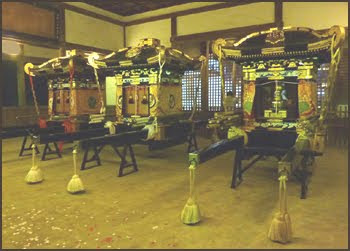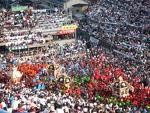:::::::::::::::::::::::::::::::::::::::::::::::::::::::::::::::::::::::::::::::::::::::::::::::::::
Nada Fighting Festival (Nada no Kenka Matsuri)
***** Location: Himeji, Hyogo
***** Season: Late Autumn
***** Category: Observance
*****************************
Explanation
October 14th and 15th
Matsubara Hachiman Shrine
Shirahama-cho Ko, Himeji City, Hyogo Prefecture
姫路 松原八幡神社
灘のけんか祭り
This is the biggest "fighting festival" in Japan.
The night of the tenth lunar month was the full moon night of Autumn in the Asian lunar calendar.

quote
Portable shrines fiercely jolted against one another produce breathtaking scenes befitting a 'Fighting Festival'
It came to be called by this name, Kenka Matsuri or 'Fighting Festival' because the mikoshi (portable shrines) are jolted against one another when carried on the shoulders of the men in the parade.
There are no detailed rules or opponents for the vehement collisions of the portable shrines. As soon as the portable shrines are set properly on the men's shoulders and everyone is ready, they are knocked against one another at random, and the moment a portable shrine is hoisted on top of another, the contest is over.
The greatest attraction is the struggle among 3 portable shrines when men over 35 wearing white headbands, those of 26-35 with yellow headbands and youths under 26 marked by red headbands, holding bamboo poles in their hands, join in the fight. A vehement struggle unfolds but this is in no way a fight between the men. This festival, which is the largest of the numerous fighting festivals held nationwide, is not only famous in Japan but is also becoming widely known overseas.
The highlight of this festival is Yatai-neri, the parade of "yatai", festival floats, gorgeously decorated with wood carving, gold and silver handiwork and embroidered curtains. The yatai are carried on the shoulders of men and are surrounded by the men holding "shide" (bamboo poles decorated with colorful paper) in their hand. As dusk sets in, illuminations on each of the yatai are lit.
source : www.jnto.go.jp
:::::::::::::::::::::::::::::::::::::::::::::::::::::::::::::::::::::::::::::::::::::::::::::::::::
There are seven districts of the town which carry their own highly decorated portable shrines (yatai 屋台) in the procession. The shrines are very heavy and are pulled and pushed on wheels. More than 3000 men take part in the various processions, and all children are proud when they are allowed to participate for the first time.
A famous group of lion dancers and drums accompany the procession.
The yatai come from 木場、松原、八家、妻鹿、宇佐崎、中村. The seventh village group does not participate, but carries the three large banners of the deities.
The yatai rub each other (neriawase 練り合わせ). When it gets dark, each yatai is decorated with lanterns.

三の丸・一の丸・二の丸 Boat three, one and two
The three portable shrines for the final fighting are much lighter and made for destruction. Every year before the festival it takes their bearers about one month to repair them, only to carry them out on the festival day to be destroyed again.
The three "boats" carry the three deities
Hondawake no mikoto 品陀和気命(ほんだわけのみこと)- Ojin Tenno (son of Jingu) in the center (later to be deified as Hachiman)
Okinagatarashi hime no mikoto
息長足姫命(おきながたらしひめのみこと)
- Emperess Jingu on the left
Hime Ookami 比咩大神(ひめおおかみ)- wife of Hachiman
The legend of the shrine tells about a fisherman from Mega, who found a plank on the shore with the inscription "Great Bosatsu Hachiman"
八幡大菩薩 and a shrine was erected to honor this plank, which was supposed to come from Usa Jingu. (See Jingu, link below.)
. . . . .
The origin of these fighting mikoshi, which are counted boats (maru) in this shrine, dates back to the Emperess Jingu Kogo 神功皇后 (Jinguu Koogoo), who was on a war expedition against Korea when she passed Himeji. The boats of her entourage were covered with oyster shells and she thought a quick way to remove them would be to bang and rub the boats against each other.
Today's "fight" is in memory of this legend.

On the evening before the main festival (yoi miya 宵宮, yoi no miya 宵の宮), all the portable shrines are paraded around town and to the main shrine. Before participating, the men have to take an ablution in the cold waters of the sea at Shirahama 白浜町.
On the second day of the festival (honmiya 本宮) the portable shrines first carried around to "wipe off the dew" (tsuyu harai 露払い), together with the lion dancers and drums.

Then they are carried up a steep slope in the west of the compount, to a "travel station" 御旅山 with the main Hachiman Shrine as an offering for the deities.
When coming back they have to pass the Sakura Gate of the Shrine, which is so low that part of the roof decoration has to be taken down before they can pass and get the blessing of the Shinto priest.
When they are back in the shrine compound, the real fight of the three boats begins, often lasting until late in the night, until all the boats are brought to fall on the ground. The men are quite exhausted from carrying the heave loads all day long, but they never give up.

The portable shrine bearers are called "neriko 練り子. They wear a special amulet in the color of their group around their arms 腕守り, given to them by mother or wife, for protection against injuries in the heavy battles. A nearby hospital is on stand-by just in case. There have been two cases of death by being crushed in recent years.

Many visitors are lined up in seats around the main "arena" in the temple ground and along the roads.
:::::::::::::::::::::::::::::::::::::::::::::::::::::::::::::::::::::::::::::::::::::::::::::::::::::
. Emperess Jingu and the Hachiman Cult
. Jingu Kogo 神功皇后 and Japanese Dolls .
*****************************
Worldwide use
*****************************
Things found on the way
*****************************
HAIKU
灘けんか祭 Nada Kenka Matsuri

秋晴を来る総代の黒羽織
akibare no kuru soodai no kuro haori
in autumn sunshine
the representatives in their
formal black coats
Asazuma Chikara 朝妻力
source : 俳誌のsalon
:::::::::::::::::::::::::::::::::::::::::::::::::::::::::::::::::::::::::::::::::::::::::::::::::::
*****************************
Related words
***** WKD : Autumn Festival (aki matsuri)
BACK : Top of this Saijiki
[ . BACK to WORLDKIGO . TOP . ]
:::::::::::::::::::::::::::::::::::::::::::::::::::::::::::::::::::::::::::::::::::::::::::::::::::::






No comments:
Post a Comment